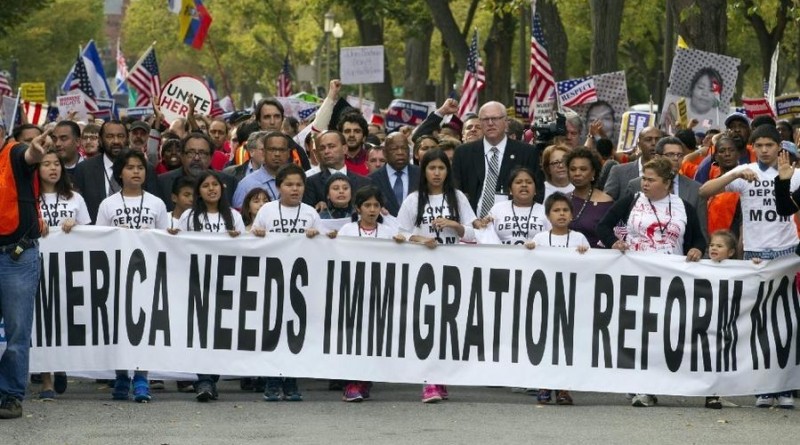Heritage Foundation: How Much Does Illegal Immigration Cost You?
Unlawful immigration and amnesty for current unlawful immigrants can pose large fiscal costs for U.S. taxpayers. Government provides four types of benefits and services that are relevant to this issue:
- Direct benefits. These include Social Security, Medicare, unemployment insurance, and workers’ compensation.
- Means-tested welfare benefits. There are over 80 of these programs which, at a cost of nearly $900 billion per year, provide cash, food, housing, medical, and other services to roughly 100 million low-income Americans. Major programs include Medicaid, food stamps, the refundable Earned Income Tax Credit, public housing, Supplemental Security Income, and Temporary Assistance for Needy Families.
- Public education. At a cost of $12,300 per pupil per year, these services are largely free or heavily subsidized for low-income parents.
- Population-based services. Police, fire, highways, parks, and similar services, as the National Academy of Sciences determined in its study of the fiscal costs of immigration, generally have to expand as new immigrants enter a community; someone has to bear the cost of that expansion.
The cost of these governmental services is far larger than many people imagine. For example, in 2010, the average U.S. household received $31,584 in government benefits and services in these four categories.
The governmental system is highly redistributive. Well-educated households tend to be net tax contributors: The taxes they pay exceed the direct and means-tested benefits, education, and population-based services they receive. For example, in 2010, in the whole U.S. population, households with college-educated heads, on average, received $24,839 in government benefits while paying $54,089 in taxes. The average college-educated household thus generated a fiscal surplus of $29,250 that government used to finance benefits for other households.
Other households are net tax consumers: The benefits they receive exceed the taxes they pay. These households generate a “fiscal deficit” that must be financed by taxes from other households or by government borrowing. For example, in 2010, in the U.S. population as a whole, households headed by persons without a high school degree, on average, received $46,582 in government benefits while paying only $11,469 in taxes. This generated an average fiscal deficit (benefits received minus taxes paid) of $35,113.
The high deficits of poorly educated households are important in the amnesty debate because the typical unlawful immigrant has only a 10th-grade education. Half of unlawful immigrant households are headed by an individual with less than a high school degree, and another 25 percent of household heads have only a high school degree.
Some argue that the deficit figures for poorly educated households in the general population are not relevant for immigrants. Many believe, for example, that lawful immigrants use little welfare. In reality, lawful immigrant households receive significantly more welfare, on average, than U.S.-born households. Overall, the fiscal deficits or surpluses for lawful immigrant households are the same as or higher than those for U.S.-born households with the same education level. Poorly educated households, whether immigrant or U.S.-born, receive far more in government benefits than they pay in taxes.
In contrast to lawful immigrants, unlawful immigrants at present do not have access to means-tested welfare, Social Security, or Medicare. This does not mean, however, that they do not receive government benefits and services. Children in unlawful immigrant households receive heavily subsidized public education. Many unlawful immigrants have U.S.-born children; these children are currently eligible for the full range of government welfare and medical benefits. And, of course, when unlawful immigrants live in a community, they use roads, parks, sewers, police, and fire protection; these services must expand to cover the added population or there will be “congestion” effects that lead to a decline in service quality.
In 2010, the average unlawful immigrant household received around $24,721 in government benefits and services while paying some $10,334 in taxes. This generated an average annual fiscal deficit (benefits received minus taxes paid) of around $14,387 per household. This cost had to be borne by U.S. taxpayers. Amnesty would provide unlawful households with access to over 80 means-tested welfare programs, Obamacare, Social Security, and Medicare. The fiscal deficit for each household would soar.
If enacted, amnesty would be implemented in phases. During the first or interim phase (which is likely to last 13 years), unlawful immigrants would be given lawful status but would be denied access to means-tested welfare and Obamacare. Most analysts assume that roughly half of unlawful immigrants work “off the books” and therefore do not pay income or FICA taxes. During the interim phase, these “off the books” workers would have a strong incentive to move to “on the books” employment. In addition, their wages would likely go up as they sought jobs in a more open environment. As a result, during the interim period, tax payments would rise and the average fiscal deficit among former unlawful immigrant households would fall.
After 13 years, unlawful immigrants would become eligible for means-tested welfare and Obamacare. At that point or shortly thereafter, former unlawful immigrant households would likely begin to receive government benefits at the same rate as lawful immigrant households of the same education level. As a result, government spending and fiscal deficits would increase dramatically.
The final phase of amnesty is retirement. Unlawful immigrants are not currently eligible for Social Security and Medicare, but under amnesty they would become so. The cost of this change would be very large indeed.



Pingback: 10 Indications That Western Society Is Collapsing – Whatshappen
Pingback: 10 Indications That Western Society Is Collapsing – oourworld.top
Pingback: 10 Indications That Western Society Is Collapsing